HA 3011 Advanced Financial Accounting: Enron, Walmart & Measurement
VerifiedAdded on 2023/06/04
|7
|2396
|73
Report
AI Summary
This report provides an in-depth analysis of Enron's accounting practices, specifically focusing on the misuse of mark-to-market accounting and the utilization of special purpose entities to achieve financial reporting objectives. It examines how Enron's management manipulated these methods to present a favorable financial picture, including examples of inflated revenue recognition and hidden debt. Additionally, the report explores the role of stock options in incentivizing Enron's top management and the implications of this compensation structure under agency theory. The second part of the report describes and analyzes the different ways that the five elements of financial elements can be measured by listed companies using Walmart as an example, highlighting the measurement methodologies used for revenue, assets, liabilities, and expenses, and evaluating the decision-usefulness of the information provided. It also discusses Walmart's use of both GAAP and non-GAAP financial measures and their impact on financial analysis.
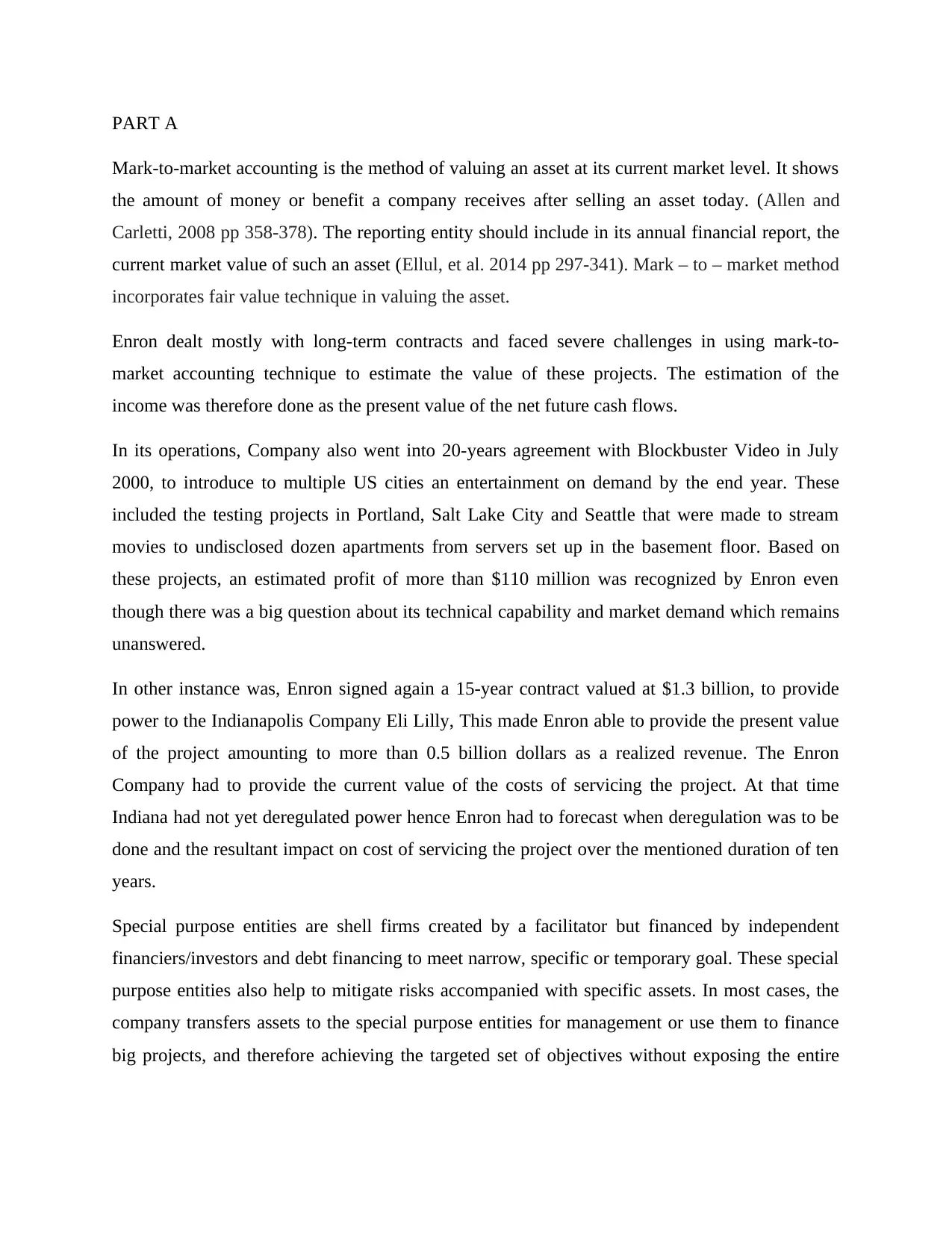
PART A
Mark-to-market accounting is the method of valuing an asset at its current market level. It shows
the amount of money or benefit a company receives after selling an asset today. (Allen and
Carletti, 2008 pp 358-378). The reporting entity should include in its annual financial report, the
current market value of such an asset (Ellul, et al. 2014 pp 297-341). Mark – to – market method
incorporates fair value technique in valuing the asset.
Enron dealt mostly with long-term contracts and faced severe challenges in using mark-to-
market accounting technique to estimate the value of these projects. The estimation of the
income was therefore done as the present value of the net future cash flows.
In its operations, Company also went into 20-years agreement with Blockbuster Video in July
2000, to introduce to multiple US cities an entertainment on demand by the end year. These
included the testing projects in Portland, Salt Lake City and Seattle that were made to stream
movies to undisclosed dozen apartments from servers set up in the basement floor. Based on
these projects, an estimated profit of more than $110 million was recognized by Enron even
though there was a big question about its technical capability and market demand which remains
unanswered.
In other instance was, Enron signed again a 15-year contract valued at $1.3 billion, to provide
power to the Indianapolis Company Eli Lilly, This made Enron able to provide the present value
of the project amounting to more than 0.5 billion dollars as a realized revenue. The Enron
Company had to provide the current value of the costs of servicing the project. At that time
Indiana had not yet deregulated power hence Enron had to forecast when deregulation was to be
done and the resultant impact on cost of servicing the project over the mentioned duration of ten
years.
Special purpose entities are shell firms created by a facilitator but financed by independent
financiers/investors and debt financing to meet narrow, specific or temporary goal. These special
purpose entities also help to mitigate risks accompanied with specific assets. In most cases, the
company transfers assets to the special purpose entities for management or use them to finance
big projects, and therefore achieving the targeted set of objectives without exposing the entire
Mark-to-market accounting is the method of valuing an asset at its current market level. It shows
the amount of money or benefit a company receives after selling an asset today. (Allen and
Carletti, 2008 pp 358-378). The reporting entity should include in its annual financial report, the
current market value of such an asset (Ellul, et al. 2014 pp 297-341). Mark – to – market method
incorporates fair value technique in valuing the asset.
Enron dealt mostly with long-term contracts and faced severe challenges in using mark-to-
market accounting technique to estimate the value of these projects. The estimation of the
income was therefore done as the present value of the net future cash flows.
In its operations, Company also went into 20-years agreement with Blockbuster Video in July
2000, to introduce to multiple US cities an entertainment on demand by the end year. These
included the testing projects in Portland, Salt Lake City and Seattle that were made to stream
movies to undisclosed dozen apartments from servers set up in the basement floor. Based on
these projects, an estimated profit of more than $110 million was recognized by Enron even
though there was a big question about its technical capability and market demand which remains
unanswered.
In other instance was, Enron signed again a 15-year contract valued at $1.3 billion, to provide
power to the Indianapolis Company Eli Lilly, This made Enron able to provide the present value
of the project amounting to more than 0.5 billion dollars as a realized revenue. The Enron
Company had to provide the current value of the costs of servicing the project. At that time
Indiana had not yet deregulated power hence Enron had to forecast when deregulation was to be
done and the resultant impact on cost of servicing the project over the mentioned duration of ten
years.
Special purpose entities are shell firms created by a facilitator but financed by independent
financiers/investors and debt financing to meet narrow, specific or temporary goal. These special
purpose entities also help to mitigate risks accompanied with specific assets. In most cases, the
company transfers assets to the special purpose entities for management or use them to finance
big projects, and therefore achieving the targeted set of objectives without exposing the entire
Paraphrase This Document
Need a fresh take? Get an instant paraphrase of this document with our AI Paraphraser
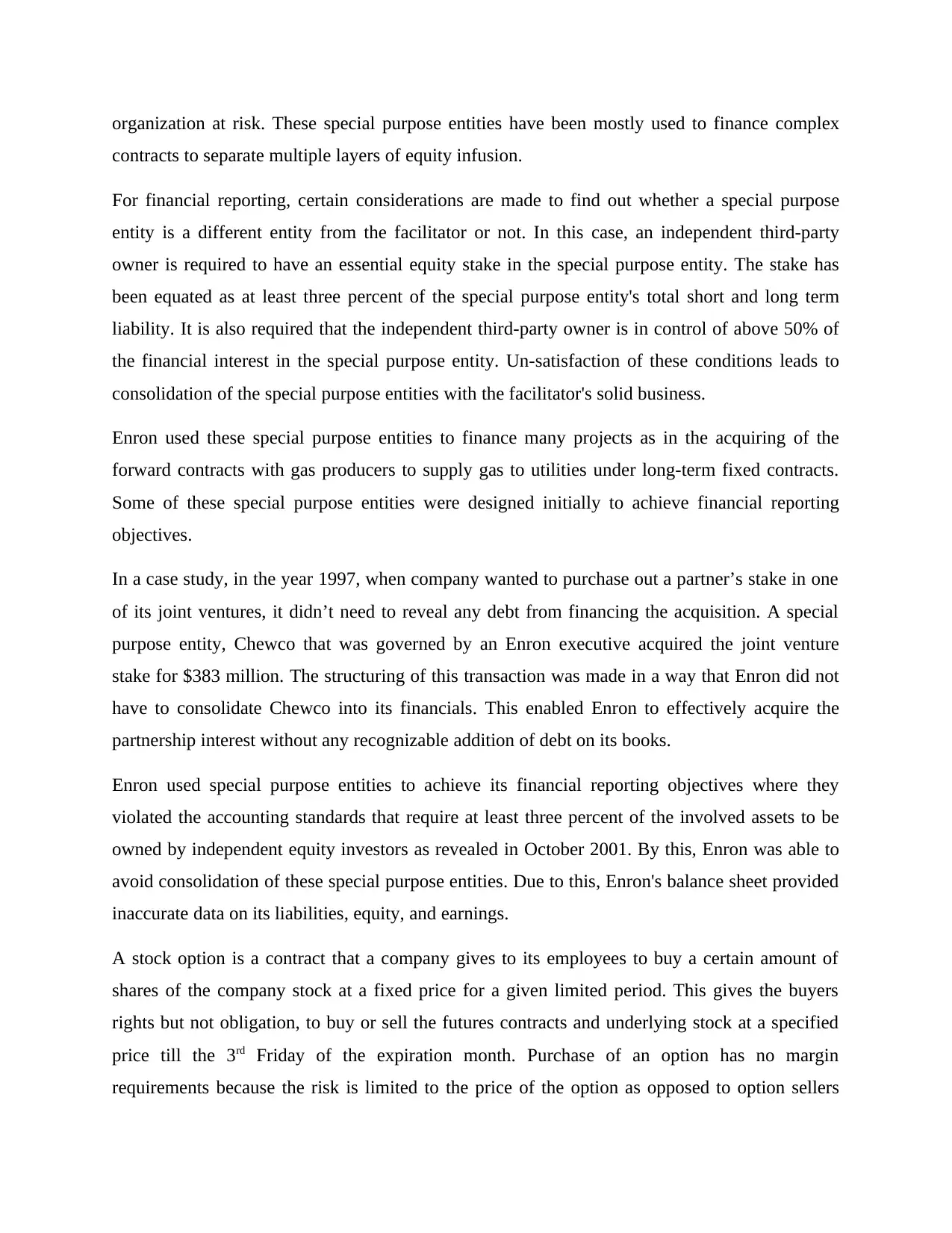
organization at risk. These special purpose entities have been mostly used to finance complex
contracts to separate multiple layers of equity infusion.
For financial reporting, certain considerations are made to find out whether a special purpose
entity is a different entity from the facilitator or not. In this case, an independent third-party
owner is required to have an essential equity stake in the special purpose entity. The stake has
been equated as at least three percent of the special purpose entity's total short and long term
liability. It is also required that the independent third-party owner is in control of above 50% of
the financial interest in the special purpose entity. Un-satisfaction of these conditions leads to
consolidation of the special purpose entities with the facilitator's solid business.
Enron used these special purpose entities to finance many projects as in the acquiring of the
forward contracts with gas producers to supply gas to utilities under long-term fixed contracts.
Some of these special purpose entities were designed initially to achieve financial reporting
objectives.
In a case study, in the year 1997, when company wanted to purchase out a partner’s stake in one
of its joint ventures, it didn’t need to reveal any debt from financing the acquisition. A special
purpose entity, Chewco that was governed by an Enron executive acquired the joint venture
stake for $383 million. The structuring of this transaction was made in a way that Enron did not
have to consolidate Chewco into its financials. This enabled Enron to effectively acquire the
partnership interest without any recognizable addition of debt on its books.
Enron used special purpose entities to achieve its financial reporting objectives where they
violated the accounting standards that require at least three percent of the involved assets to be
owned by independent equity investors as revealed in October 2001. By this, Enron was able to
avoid consolidation of these special purpose entities. Due to this, Enron's balance sheet provided
inaccurate data on its liabilities, equity, and earnings.
A stock option is a contract that a company gives to its employees to buy a certain amount of
shares of the company stock at a fixed price for a given limited period. This gives the buyers
rights but not obligation, to buy or sell the futures contracts and underlying stock at a specified
price till the 3rd Friday of the expiration month. Purchase of an option has no margin
requirements because the risk is limited to the price of the option as opposed to option sellers
contracts to separate multiple layers of equity infusion.
For financial reporting, certain considerations are made to find out whether a special purpose
entity is a different entity from the facilitator or not. In this case, an independent third-party
owner is required to have an essential equity stake in the special purpose entity. The stake has
been equated as at least three percent of the special purpose entity's total short and long term
liability. It is also required that the independent third-party owner is in control of above 50% of
the financial interest in the special purpose entity. Un-satisfaction of these conditions leads to
consolidation of the special purpose entities with the facilitator's solid business.
Enron used these special purpose entities to finance many projects as in the acquiring of the
forward contracts with gas producers to supply gas to utilities under long-term fixed contracts.
Some of these special purpose entities were designed initially to achieve financial reporting
objectives.
In a case study, in the year 1997, when company wanted to purchase out a partner’s stake in one
of its joint ventures, it didn’t need to reveal any debt from financing the acquisition. A special
purpose entity, Chewco that was governed by an Enron executive acquired the joint venture
stake for $383 million. The structuring of this transaction was made in a way that Enron did not
have to consolidate Chewco into its financials. This enabled Enron to effectively acquire the
partnership interest without any recognizable addition of debt on its books.
Enron used special purpose entities to achieve its financial reporting objectives where they
violated the accounting standards that require at least three percent of the involved assets to be
owned by independent equity investors as revealed in October 2001. By this, Enron was able to
avoid consolidation of these special purpose entities. Due to this, Enron's balance sheet provided
inaccurate data on its liabilities, equity, and earnings.
A stock option is a contract that a company gives to its employees to buy a certain amount of
shares of the company stock at a fixed price for a given limited period. This gives the buyers
rights but not obligation, to buy or sell the futures contracts and underlying stock at a specified
price till the 3rd Friday of the expiration month. Purchase of an option has no margin
requirements because the risk is limited to the price of the option as opposed to option sellers

who require a healthy margin since they have obligations to buy or sell the underlying
instruments in case an assigned option holder exercises their option.
Enron’s top management was highly compensated using stock option awards that were linked to
short-term stock prices. The management focused on creating expectations of rapid growth to its
employees with the aim of puffing up reported earnings to meet the Wall Street’s expectations.
The main intent of using stock options for compensations was to align the interest of the
management with shareholders as a motivation that could help in better decision making and
help pump up short-term stock performance.
PART 2
Examples of measurement methodologies from a company's annual reports include; cost value to
measure asset, historical cost base, fair value to measure asset and liability, cash basis and
accrual basis to measure expenses (Walmart Annual Report, 2015). These methodologies are
commonly used in measuring the financial elements and at the same time evaluating the
Company performance.
Please note, on our case here, we will us Walmart Company, one of the leading American retail
corporations with chain of stores around US and it is formed in 1962 by Sam Walton.
Following criteria has used by the Walmart Company to measure the following financial
elements;
Revenue/Receivables – the company measure receivable at their carrying value of the
consideration received or receivable less cash and cash equivalent or net of a reserve for doubtful
accounts. That is, revenue or receivable is reported at the current market fair value at the time of
the transaction.
Assets - The assets are stated at the fair value, and the gains or losses on disposal are recognized
as incurred. The cost of the additional asset is capitalized, less the expense when incurred.
instruments in case an assigned option holder exercises their option.
Enron’s top management was highly compensated using stock option awards that were linked to
short-term stock prices. The management focused on creating expectations of rapid growth to its
employees with the aim of puffing up reported earnings to meet the Wall Street’s expectations.
The main intent of using stock options for compensations was to align the interest of the
management with shareholders as a motivation that could help in better decision making and
help pump up short-term stock performance.
PART 2
Examples of measurement methodologies from a company's annual reports include; cost value to
measure asset, historical cost base, fair value to measure asset and liability, cash basis and
accrual basis to measure expenses (Walmart Annual Report, 2015). These methodologies are
commonly used in measuring the financial elements and at the same time evaluating the
Company performance.
Please note, on our case here, we will us Walmart Company, one of the leading American retail
corporations with chain of stores around US and it is formed in 1962 by Sam Walton.
Following criteria has used by the Walmart Company to measure the following financial
elements;
Revenue/Receivables – the company measure receivable at their carrying value of the
consideration received or receivable less cash and cash equivalent or net of a reserve for doubtful
accounts. That is, revenue or receivable is reported at the current market fair value at the time of
the transaction.
Assets - The assets are stated at the fair value, and the gains or losses on disposal are recognized
as incurred. The cost of the additional asset is capitalized, less the expense when incurred.
⊘ This is a preview!⊘
Do you want full access?
Subscribe today to unlock all pages.

Trusted by 1+ million students worldwide
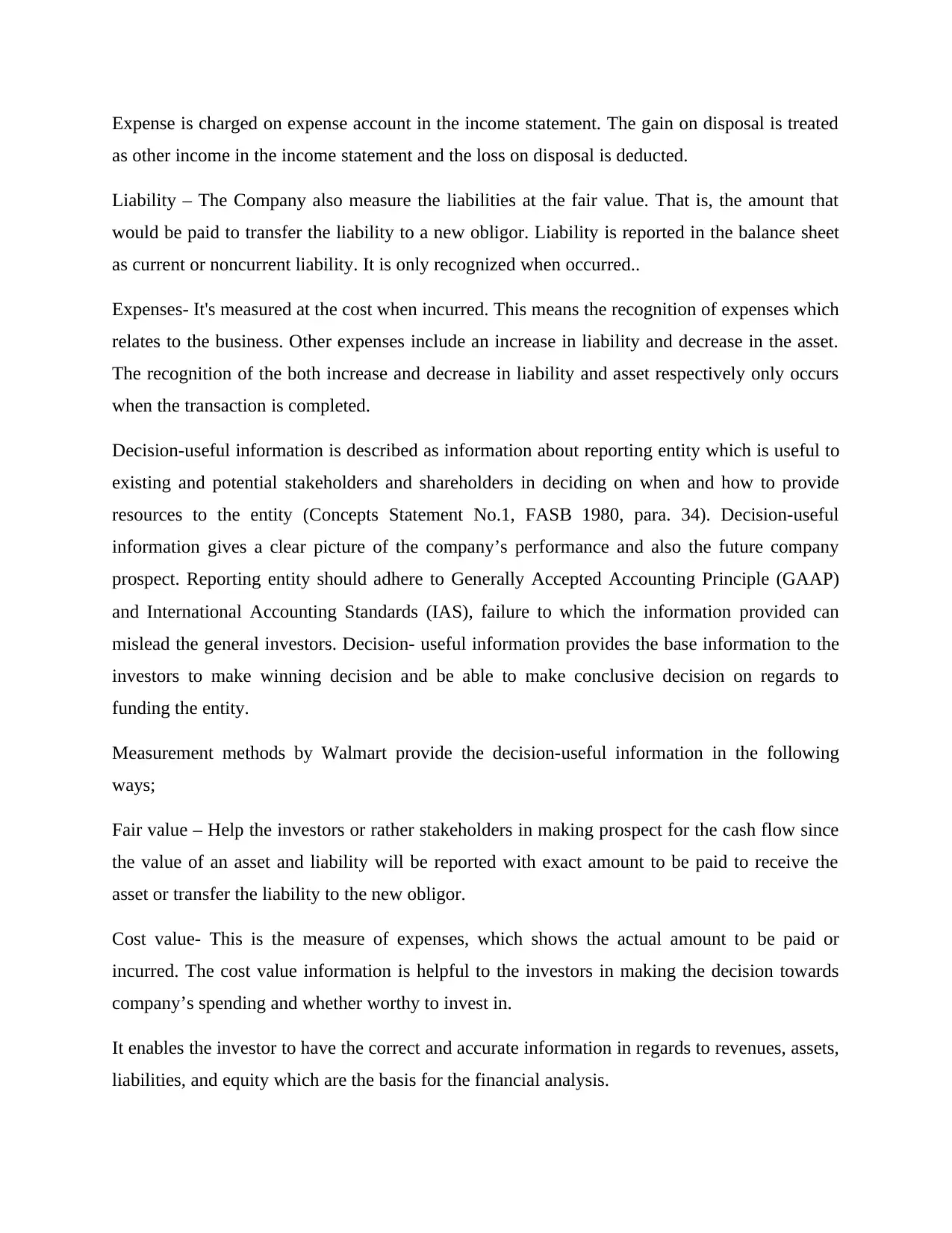
Expense is charged on expense account in the income statement. The gain on disposal is treated
as other income in the income statement and the loss on disposal is deducted.
Liability – The Company also measure the liabilities at the fair value. That is, the amount that
would be paid to transfer the liability to a new obligor. Liability is reported in the balance sheet
as current or noncurrent liability. It is only recognized when occurred..
Expenses- It's measured at the cost when incurred. This means the recognition of expenses which
relates to the business. Other expenses include an increase in liability and decrease in the asset.
The recognition of the both increase and decrease in liability and asset respectively only occurs
when the transaction is completed.
Decision-useful information is described as information about reporting entity which is useful to
existing and potential stakeholders and shareholders in deciding on when and how to provide
resources to the entity (Concepts Statement No.1, FASB 1980, para. 34). Decision-useful
information gives a clear picture of the company’s performance and also the future company
prospect. Reporting entity should adhere to Generally Accepted Accounting Principle (GAAP)
and International Accounting Standards (IAS), failure to which the information provided can
mislead the general investors. Decision- useful information provides the base information to the
investors to make winning decision and be able to make conclusive decision on regards to
funding the entity.
Measurement methods by Walmart provide the decision-useful information in the following
ways;
Fair value – Help the investors or rather stakeholders in making prospect for the cash flow since
the value of an asset and liability will be reported with exact amount to be paid to receive the
asset or transfer the liability to the new obligor.
Cost value- This is the measure of expenses, which shows the actual amount to be paid or
incurred. The cost value information is helpful to the investors in making the decision towards
company’s spending and whether worthy to invest in.
It enables the investor to have the correct and accurate information in regards to revenues, assets,
liabilities, and equity which are the basis for the financial analysis.
as other income in the income statement and the loss on disposal is deducted.
Liability – The Company also measure the liabilities at the fair value. That is, the amount that
would be paid to transfer the liability to a new obligor. Liability is reported in the balance sheet
as current or noncurrent liability. It is only recognized when occurred..
Expenses- It's measured at the cost when incurred. This means the recognition of expenses which
relates to the business. Other expenses include an increase in liability and decrease in the asset.
The recognition of the both increase and decrease in liability and asset respectively only occurs
when the transaction is completed.
Decision-useful information is described as information about reporting entity which is useful to
existing and potential stakeholders and shareholders in deciding on when and how to provide
resources to the entity (Concepts Statement No.1, FASB 1980, para. 34). Decision-useful
information gives a clear picture of the company’s performance and also the future company
prospect. Reporting entity should adhere to Generally Accepted Accounting Principle (GAAP)
and International Accounting Standards (IAS), failure to which the information provided can
mislead the general investors. Decision- useful information provides the base information to the
investors to make winning decision and be able to make conclusive decision on regards to
funding the entity.
Measurement methods by Walmart provide the decision-useful information in the following
ways;
Fair value – Help the investors or rather stakeholders in making prospect for the cash flow since
the value of an asset and liability will be reported with exact amount to be paid to receive the
asset or transfer the liability to the new obligor.
Cost value- This is the measure of expenses, which shows the actual amount to be paid or
incurred. The cost value information is helpful to the investors in making the decision towards
company’s spending and whether worthy to invest in.
It enables the investor to have the correct and accurate information in regards to revenues, assets,
liabilities, and equity which are the basis for the financial analysis.
Paraphrase This Document
Need a fresh take? Get an instant paraphrase of this document with our AI Paraphraser
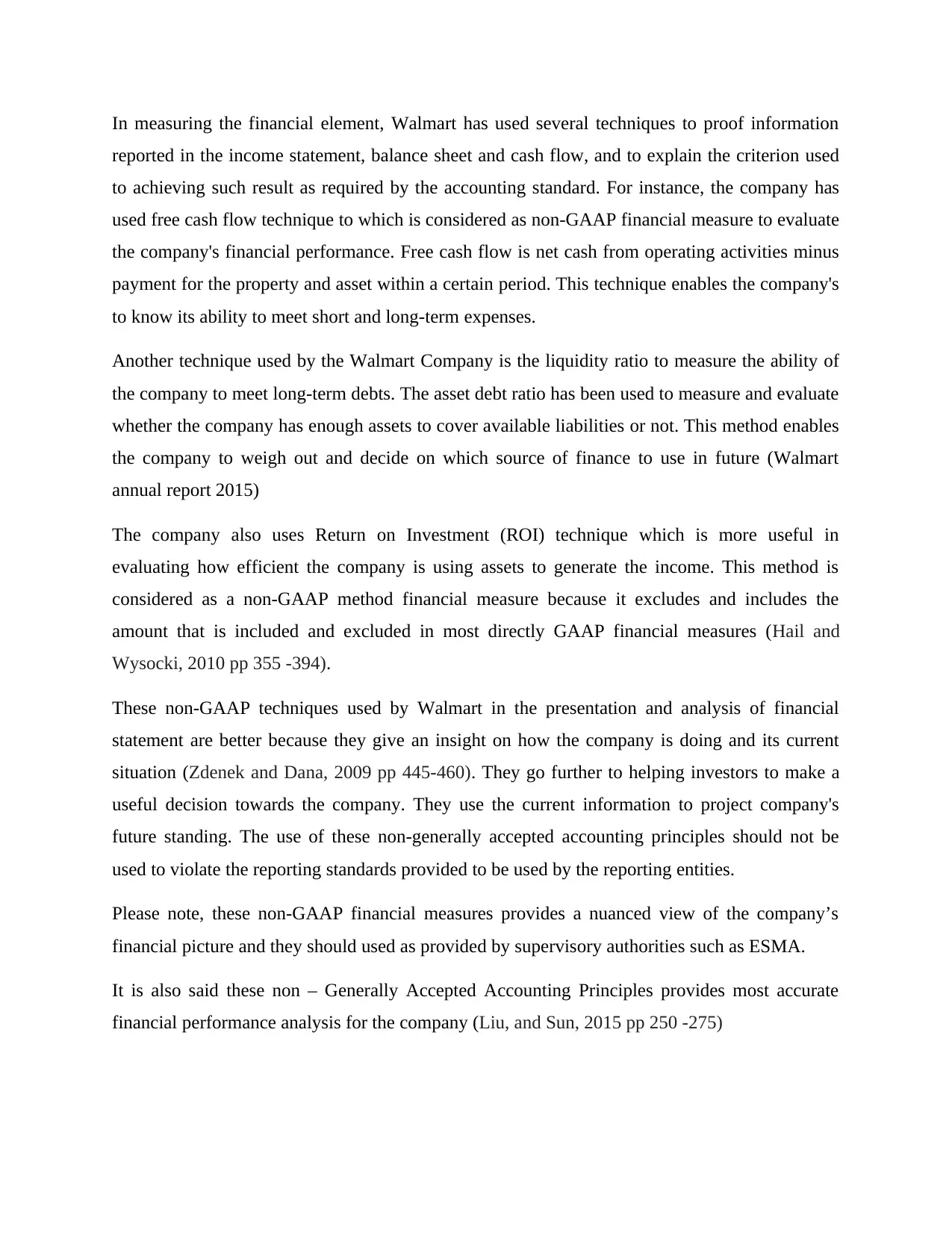
In measuring the financial element, Walmart has used several techniques to proof information
reported in the income statement, balance sheet and cash flow, and to explain the criterion used
to achieving such result as required by the accounting standard. For instance, the company has
used free cash flow technique to which is considered as non-GAAP financial measure to evaluate
the company's financial performance. Free cash flow is net cash from operating activities minus
payment for the property and asset within a certain period. This technique enables the company's
to know its ability to meet short and long-term expenses.
Another technique used by the Walmart Company is the liquidity ratio to measure the ability of
the company to meet long-term debts. The asset debt ratio has been used to measure and evaluate
whether the company has enough assets to cover available liabilities or not. This method enables
the company to weigh out and decide on which source of finance to use in future (Walmart
annual report 2015)
The company also uses Return on Investment (ROI) technique which is more useful in
evaluating how efficient the company is using assets to generate the income. This method is
considered as a non-GAAP method financial measure because it excludes and includes the
amount that is included and excluded in most directly GAAP financial measures (Hail and
Wysocki, 2010 pp 355 -394).
These non-GAAP techniques used by Walmart in the presentation and analysis of financial
statement are better because they give an insight on how the company is doing and its current
situation (Zdenek and Dana, 2009 pp 445-460). They go further to helping investors to make a
useful decision towards the company. They use the current information to project company's
future standing. The use of these non-generally accepted accounting principles should not be
used to violate the reporting standards provided to be used by the reporting entities.
Please note, these non-GAAP financial measures provides a nuanced view of the company’s
financial picture and they should used as provided by supervisory authorities such as ESMA.
It is also said these non – Generally Accepted Accounting Principles provides most accurate
financial performance analysis for the company (Liu, and Sun, 2015 pp 250 -275)
reported in the income statement, balance sheet and cash flow, and to explain the criterion used
to achieving such result as required by the accounting standard. For instance, the company has
used free cash flow technique to which is considered as non-GAAP financial measure to evaluate
the company's financial performance. Free cash flow is net cash from operating activities minus
payment for the property and asset within a certain period. This technique enables the company's
to know its ability to meet short and long-term expenses.
Another technique used by the Walmart Company is the liquidity ratio to measure the ability of
the company to meet long-term debts. The asset debt ratio has been used to measure and evaluate
whether the company has enough assets to cover available liabilities or not. This method enables
the company to weigh out and decide on which source of finance to use in future (Walmart
annual report 2015)
The company also uses Return on Investment (ROI) technique which is more useful in
evaluating how efficient the company is using assets to generate the income. This method is
considered as a non-GAAP method financial measure because it excludes and includes the
amount that is included and excluded in most directly GAAP financial measures (Hail and
Wysocki, 2010 pp 355 -394).
These non-GAAP techniques used by Walmart in the presentation and analysis of financial
statement are better because they give an insight on how the company is doing and its current
situation (Zdenek and Dana, 2009 pp 445-460). They go further to helping investors to make a
useful decision towards the company. They use the current information to project company's
future standing. The use of these non-generally accepted accounting principles should not be
used to violate the reporting standards provided to be used by the reporting entities.
Please note, these non-GAAP financial measures provides a nuanced view of the company’s
financial picture and they should used as provided by supervisory authorities such as ESMA.
It is also said these non – Generally Accepted Accounting Principles provides most accurate
financial performance analysis for the company (Liu, and Sun, 2015 pp 250 -275)
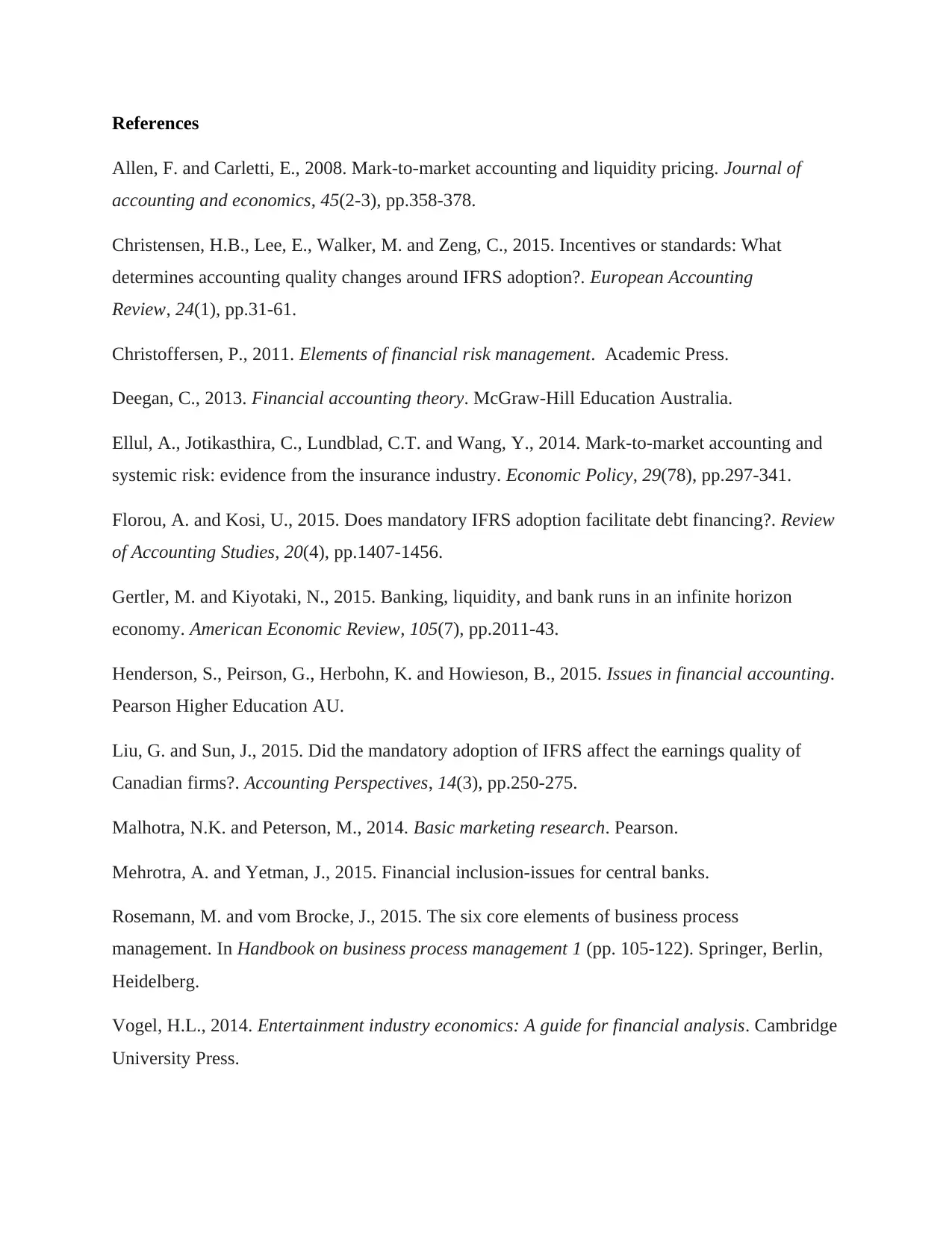
References
Allen, F. and Carletti, E., 2008. Mark-to-market accounting and liquidity pricing. Journal of
accounting and economics, 45(2-3), pp.358-378.
Christensen, H.B., Lee, E., Walker, M. and Zeng, C., 2015. Incentives or standards: What
determines accounting quality changes around IFRS adoption?. European Accounting
Review, 24(1), pp.31-61.
Christoffersen, P., 2011. Elements of financial risk management. Academic Press.
Deegan, C., 2013. Financial accounting theory. McGraw-Hill Education Australia.
Ellul, A., Jotikasthira, C., Lundblad, C.T. and Wang, Y., 2014. Mark-to-market accounting and
systemic risk: evidence from the insurance industry. Economic Policy, 29(78), pp.297-341.
Florou, A. and Kosi, U., 2015. Does mandatory IFRS adoption facilitate debt financing?. Review
of Accounting Studies, 20(4), pp.1407-1456.
Gertler, M. and Kiyotaki, N., 2015. Banking, liquidity, and bank runs in an infinite horizon
economy. American Economic Review, 105(7), pp.2011-43.
Henderson, S., Peirson, G., Herbohn, K. and Howieson, B., 2015. Issues in financial accounting.
Pearson Higher Education AU.
Liu, G. and Sun, J., 2015. Did the mandatory adoption of IFRS affect the earnings quality of
Canadian firms?. Accounting Perspectives, 14(3), pp.250-275.
Malhotra, N.K. and Peterson, M., 2014. Basic marketing research. Pearson.
Mehrotra, A. and Yetman, J., 2015. Financial inclusion-issues for central banks.
Rosemann, M. and vom Brocke, J., 2015. The six core elements of business process
management. In Handbook on business process management 1 (pp. 105-122). Springer, Berlin,
Heidelberg.
Vogel, H.L., 2014. Entertainment industry economics: A guide for financial analysis. Cambridge
University Press.
Allen, F. and Carletti, E., 2008. Mark-to-market accounting and liquidity pricing. Journal of
accounting and economics, 45(2-3), pp.358-378.
Christensen, H.B., Lee, E., Walker, M. and Zeng, C., 2015. Incentives or standards: What
determines accounting quality changes around IFRS adoption?. European Accounting
Review, 24(1), pp.31-61.
Christoffersen, P., 2011. Elements of financial risk management. Academic Press.
Deegan, C., 2013. Financial accounting theory. McGraw-Hill Education Australia.
Ellul, A., Jotikasthira, C., Lundblad, C.T. and Wang, Y., 2014. Mark-to-market accounting and
systemic risk: evidence from the insurance industry. Economic Policy, 29(78), pp.297-341.
Florou, A. and Kosi, U., 2015. Does mandatory IFRS adoption facilitate debt financing?. Review
of Accounting Studies, 20(4), pp.1407-1456.
Gertler, M. and Kiyotaki, N., 2015. Banking, liquidity, and bank runs in an infinite horizon
economy. American Economic Review, 105(7), pp.2011-43.
Henderson, S., Peirson, G., Herbohn, K. and Howieson, B., 2015. Issues in financial accounting.
Pearson Higher Education AU.
Liu, G. and Sun, J., 2015. Did the mandatory adoption of IFRS affect the earnings quality of
Canadian firms?. Accounting Perspectives, 14(3), pp.250-275.
Malhotra, N.K. and Peterson, M., 2014. Basic marketing research. Pearson.
Mehrotra, A. and Yetman, J., 2015. Financial inclusion-issues for central banks.
Rosemann, M. and vom Brocke, J., 2015. The six core elements of business process
management. In Handbook on business process management 1 (pp. 105-122). Springer, Berlin,
Heidelberg.
Vogel, H.L., 2014. Entertainment industry economics: A guide for financial analysis. Cambridge
University Press.
⊘ This is a preview!⊘
Do you want full access?
Subscribe today to unlock all pages.

Trusted by 1+ million students worldwide
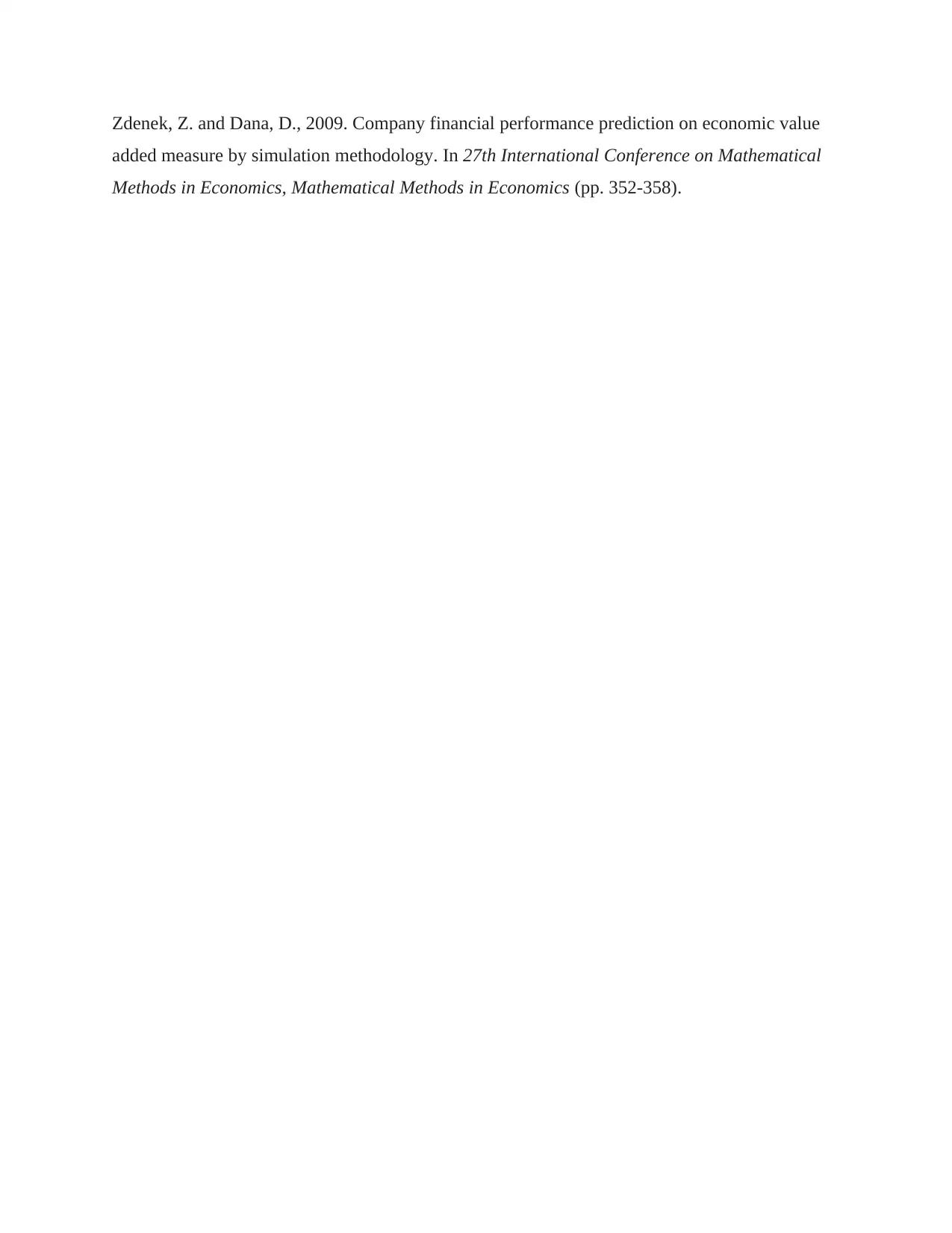
Zdenek, Z. and Dana, D., 2009. Company financial performance prediction on economic value
added measure by simulation methodology. In 27th International Conference on Mathematical
Methods in Economics, Mathematical Methods in Economics (pp. 352-358).
added measure by simulation methodology. In 27th International Conference on Mathematical
Methods in Economics, Mathematical Methods in Economics (pp. 352-358).
1 out of 7
Related Documents
Your All-in-One AI-Powered Toolkit for Academic Success.
+13062052269
info@desklib.com
Available 24*7 on WhatsApp / Email
![[object Object]](/_next/static/media/star-bottom.7253800d.svg)
Unlock your academic potential
Copyright © 2020–2025 A2Z Services. All Rights Reserved. Developed and managed by ZUCOL.



